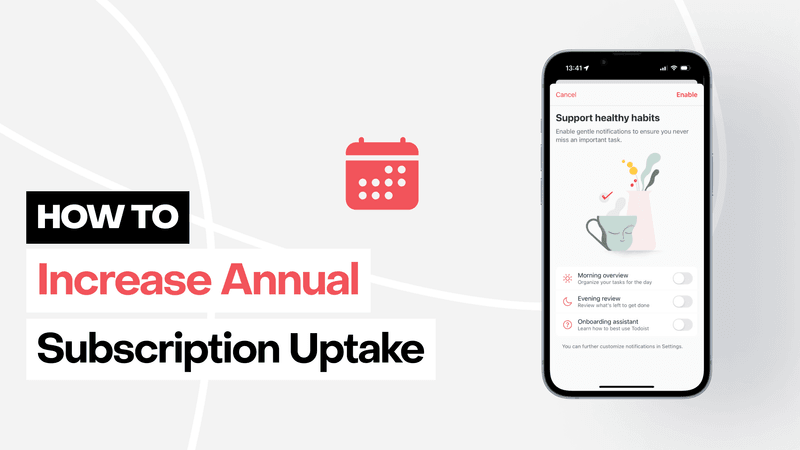Getting paid subscribers is hard, with an average of only 1.7% of downloads turning into paid subscribers in their first 30 days. For some industries, this is as low as only 0.6% converting to pay — it’s not easy being an app. Even trial conversion rate is down in popular categories like Health & Fitness, most likely due to market saturation. As a result, you’ve got to work harder than ever to get paid subscribers.
It may be tempting to focus on the easier-to-convert monthly subscribers or to steeply discount your annual subscription, but you’ll just end up with lower-quality subscribers.
Not ideal. But what is the alternative? Well, I couldn’t help but notice that Health & Fitness, Education, and Productivity apps are wildly successful at converting subscribers to one-year subscriptions.
In the Health & Fitness category, 69.4% of app subscribers go for an annual subscription. Compare this to, say, Business apps, where this is only 20.6%. Not bad, not bad at all.

But what is their secret?
It doesn’t seem to just be a matter of price point. Across different categories, the price point for weekly and monthly doesn’t seem to vary greatly, most are charging similar amounts it would seem. There is a bigger variance in annual subscription pricing with Education, Shopping, and Business having the highest price points for annual subscriptions and Travel, Productivity, and Utilities with the lowest. But there doesn’t seem to be any correlation to why categories like Education, Health & Fitness, and Productivity having higher annual subscription uptake, with Education being on the high side, Health & Fitness being in the middle, and Productivity being on the low side in terms of annual pricing.

So what could be the reason? A difference in trials? Not necessarily — there, too, the data didn’t show any specific differences. For Health & Fitness and Education, the majority are 5-9 days and Productivity is split evenly between less than 4 days and 5-9 days. This is similar to Social & Lifestyle, which has far fewer annuals and lower subscription values than Health & Fitness.
One potential cause could be that these categories suit longer-term goals, as let’s be honest, you aren’t going to hit your fitness goals or learn a new language in just a few weeks (as nice as that would be).
The other reason may be that these categories, given the size of some of the most popular brands, have gotten very effective at converting users to annual subscriptions.
So I analyzed some of the best performing apps in the category, and here are a few of the key techniques they use. I focused specifically on how and why they are so effective at getting annual subscriptions, and I hope this can inspire your own backlog of tests.
1. Runna — Leveraging referrals, trial lengths, and key pricing differentiators
With a community of 90,000+ users, Runna truly runs the running world at the moment (excuse the pun). As sad as this makes me (being a minor crowd investor in their newer competitor, Coopah), I’ve got to hand it to them: they’ve got some clever techniques.
Referral trials are longer
Runna offers a referral trial that gives you two weeks for free. This may sound short, but for these kinds of apps which tend to offer weekly plans, this is a promising duration. In general, referral customers tend to be worth more, so it’s a good move to treat them better.

This focus on referrals is definitely in response to the huge movement to start running from social media — lots of running influencers have their own referral codes. That’s actually how my colleague, Lola, started using the app and campaigned for its spot in this article.
But how is that helping annual subscriptions? Well, after this free trial, you need to either upgrade to a subscription or use the free version, which only gives you access to week one of any plan. So this longer trial comes with a commitment to an annual plan.
Another feature I really appreciated is that their annual package allows you to view all of the runs in your running plan, but monthly only shows you the runs in the upcoming month. This is a clever little change in offering that brings extra value to a dedicated runner when subscribing to an annual subscription.
2. Mimo — A special annual offer you can’t resist
While I’m not a huge fan of racing to discount annual subscriptions upfront, this definitely has its time and place. I’ve seen a huge variety in techniques:
- Offers later in the trial
- When you cancel
- A popup whilst using an app
But one of my favourites is Mimo, a coding app, which offers a special one-time discount with a countdown to introduce a sense of urgency within the basic experience.
Why do I love it so much? A lot of these countdowns are fake (oh, how you stop trusting companies when you work in growth and know all these cheeky little techniques) but Mimo’s definitely isn’t. I never saw the popup again and it was specifically for HTML’s birthday:

Don’t worry, I’m not that naive — I really don’t believe they do this only once a year. But the specific occasion and countdown works well in creating urgency.
This worked on me for Blinkist: I’d been testing them for a while, saw an annual subscription offer for 4th July (and I’m not even American) and was like, why not? A good excuse to buy a subscription.

You could test something similar, and perhaps improve upon this example by highlighting that they might not get the app for such a good price at a later point. An additional level to this test would be to follow up via email or a push notification.
3. Freedom & Todolist — Long-term onboarding messaging
Freedom app is a website and app blocking tool that aims to boost productivity. In their onboarding messaging, they include their supposed benefits, which revolves around replacing negative habits rather than gaining new ones.

It forces users to reflect on their behaviour, which probably works well for the audience; if someone has downloaded the app, they are probably quite conscious about their screen time.
By revolving their messaging around building a habit, it pushes people to think long-term and want to continue at it during onboarding.
We see this with Todolist as well with specific notification options based on why you are using the app, e.g. to organize your tasks for the day.

This is so underappreciated. The best apps I saw really push you to think long-term in all their messaging and even work with an onboarding to-do list:

This might encourage people to subscribe as it a) builds a habit out of using the app before financial commitment is made and b) shows just enough to demonstrate the value of their app.
While this is a harder point to implement, it doesn’t make it any less key. Unless users see your app as something they’ll use regularly for the foreseeable future, they are unlikely to start with an annual subscription.
How to start experimenting around this for your app
Reviewing various apps highlights that there are several ways you can work to start increasing annual subscriptions:
- Trials with annual only. For all or certain segments, you could only allow annual subscriptions after trying out an app.
- Benefits of subscription types. Differentiating beyond just the price in the value of an annual subscription.
- Limited time offers. Rather than immediately offering a discounted annual subscription, based on usage and signs of intent, present a truly limited time offer.
- Onboarding. Focusing on habit building during onboarding to encourage long-term usage of the app.
To help you start filling your backlog, here is an overview of the hypotheses and ideas based on the apps we’ve looked at:
Runna – Trials with annual only
- Hypothesis:
Because we saw that Runna offers a 2-week referral trial from running influencers, giving you full access to the app before needing to subscribe, we expect that if [app] tries the same, more people would see the value of the app and be influenced by others to subscribe. - Idea(s) on How to Execute:
Integrate an extended referral trial into sign-up. - Measure of Success:
% converting from trial to subscription.
Runna – Benefits of subscription types
- Hypothesis:
Because Runna distinguishes between monthly and yearly subscriptions in terms of access (only letting you view runs you have paid for), we expect that if [app] tries the same, more people will opt for yearly over monthly subscriptions. - Idea(s) on How to Execute:
Highlight benefits at the paywall of getting a yearly plan (beyond just cheaper pricing). - Measure of Success:
% that subscribe to yearly.
Mimo – Limited time offers
- Hypothesis:
Because Mimo provides a one-off offer with a countdown to increase urgency, we expect that if [app] does the same, we will see an increase in people subscribing. - Idea(s) on How to Execute:
Add a popup shortly after leaving the paywall offering a special one-time discount with a countdown timer.
Ensure that the timer is genuine – some apps reset the countdown every time you open the offer, which devalues the “one-time offer” feeling.
Test via email/push notifications as well. - Measure of Success:
% of people subscribing.
Todoist – Onboarding
- Hypothesis:
Because Todoist builds in habits during onboarding by requiring users to start ticking off tasks and setting goals, we expect that if [app] does the same, more people will activate during onboarding and subscribe when they realize the value of the app. - Idea(s) on How to Execute:
Add an onboarding checklist in-app and via email. - Measure of Success:
% of people activating during onboarding.
Freedom – Onboarding
- Hypothesis:
Because Freedom and Headway use messaging themed around minimizing bad habits, we expect that if [app] does the same, more people will be inclined to commit and use the app, as it plays on an emotional response. - Idea(s) on How to Execute:
Add messaging to:- App Store
- Onboarding
- Paywall with social proof
- Measure of Success:
% of people activating during onboarding, % of people subscribing.
These categories are killing it at getting annual subscribers. It isn’t just a blanket discount, lower price, or different trial length that drives their high percentage of annual subscribers, but rather a clever strategy from onboarding to pricing setup that is supporting their success.

